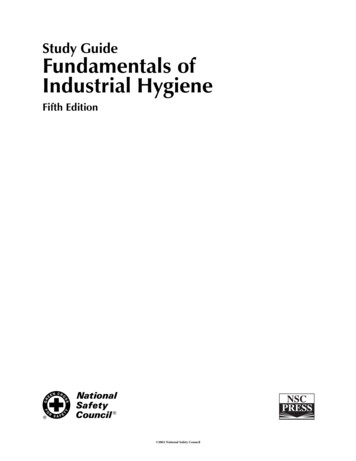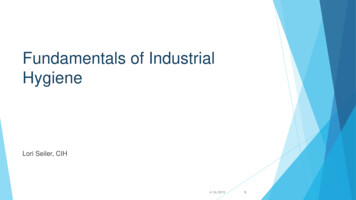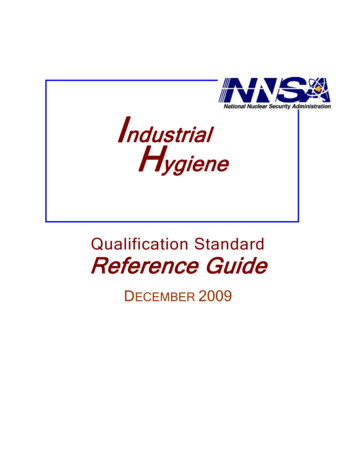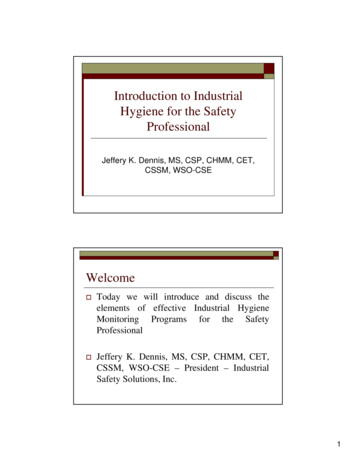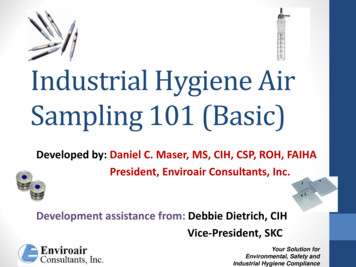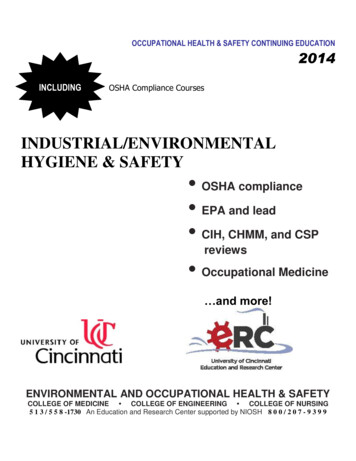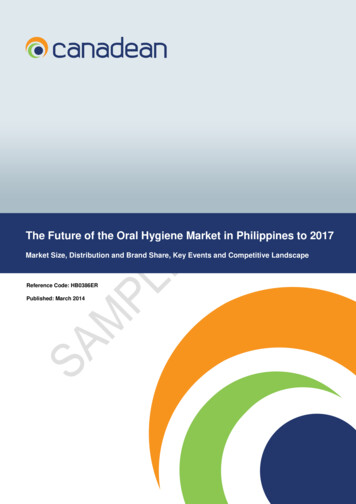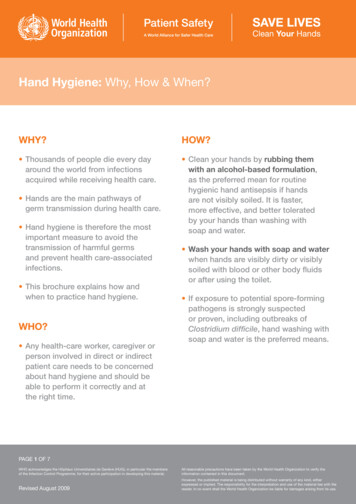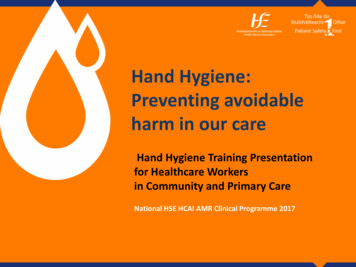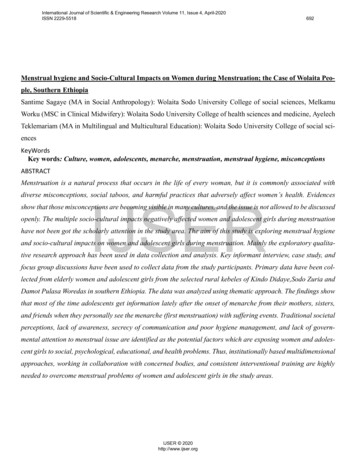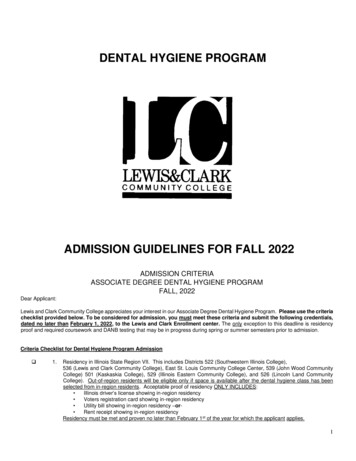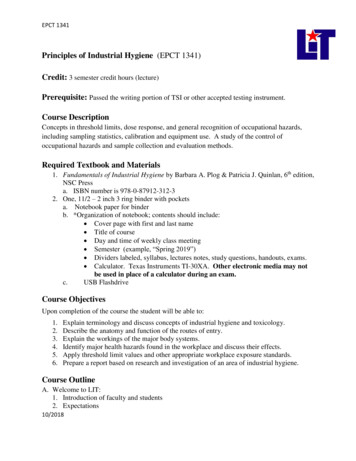
Transcription
EPCT 1341Principles of Industrial Hygiene (EPCT 1341)Credit: 3 semester credit hours (lecture)Prerequisite: Passed the writing portion of TSI or other accepted testing instrument.Course DescriptionConcepts in threshold limits, dose response, and general recognition of occupational hazards,including sampling statistics, calibration and equipment use. A study of the control ofoccupational hazards and sample collection and evaluation methods.Required Textbook and Materials1. Fundamentals of Industrial Hygiene by Barbara A. Plog & Patricia J. Quinlan, 6th edition,NSC Pressa. ISBN number is 978-0-87912-312-32. One, 11/2 – 2 inch 3 ring binder with pocketsa. Notebook paper for binderb. *Organization of notebook; contents should include: Cover page with first and last name Title of course Day and time of weekly class meeting Semester (example, “Spring 2019”) Dividers labeled, syllabus, lectures notes, study questions, handouts, exams. Calculator. Texas Instruments TI-30XA. Other electronic media may notbe used in place of a calculator during an exam.c.USB FlashdriveCourse ObjectivesUpon completion of the course the student will be able to:1.2.3.4.5.6.Explain terminology and discuss concepts of industrial hygiene and toxicology.Describe the anatomy and function of the routes of entry.Explain the workings of the major body systems.Identify major health hazards found in the workplace and discuss their effects.Apply threshold limit values and other appropriate workplace exposure standards.Prepare a report based on research and investigation of an area of industrial hygiene.Course OutlineA. Welcome to LIT:1. Introduction of faculty and students2. Expectations10/2018
EPCT 13413. PoliciesB. Industrial Hygiene1. What is it? (Overview)2. Federal RegulationsC. Lungs1. Anatomy2. Respiration3. Hazards4. Natural defenses5. AMA guides for evaluating impairmentD. Skin and Occupational Dermatosis1. Anatomy2. Physiology and functions3. Defense mechanisms4. Causes of occupational skin disease5. Predisposing factors6. Classification of occupational skin disease7. Prevention and controlE. The Ears1. Anatomy and physiology2. The hearing process3. Effects of noise exposure4. Evaluating impairment (AMA Guides)F. The Eyes1. Anatomy2. Visual performance3. Physical HazardsG. Gases, Vapors, and Solvents1. Toxicological effects2. Physiological effectsH. Industrial Toxicology1. Definition2. Routes of entry3. Dose-response relationship4. Timing: exposure and effect5. Systemic toxinsI. Particulates1. Background/basic concepts, procedures, and examples2. Crystalline, structural, and isotopic nature3. Shape of the particles4. Sized of the particles5. Dose6. Concurrent exposure to other toxic agents7. Biological reactions10/2018
EPCT 1341J. Industrial Noise1. Hearing ability2. Risk factors3. Analysis of noise exposureK. Ionizing Radiation1. Ionizing radiation terms2. Biological effects of radiationL. Nonionizing Radiation1. Types of nonionizing radiation2. Biological effects3. Exposure standardsM. Thermal Stress1. Degrees of thermal stress2. Recognition of heat stress3. Cold stressN. Biological Hazards1. Hazard identification2. Risk assessment3. Current topics in biosafety4. BioterrorismGrade ScaleA 90-100B 80-89C 70-79D 60-69F Less than 60*Notebooks will be graded the evening of the final.Course EvaluationFinal grades will be calculated according to the following criteria:1. Test I20%2. Test II20%3. Final35%4. Report15%5. Notebook5%6. Vocabulary5%Course Policies1. No food, drinks, or use of tobacco products in class.2. Computers, telephones, headphones, and any other electronic devices must be turned offwhile in class or used only with permission of the instructor.10/2018
EPCT 13413. Do not bring children to class.4. If you wish to drop a course, the student is responsible for initiating and completing the dropprocess. If you stop coming to class and fail to drop the course, you will earn an ‘F’ in thecourse.5. Additional class policies as defined by the individual course instructor are in the addendum.Disabilities StatementThe Americans with Disabilities Act of 1992 and Section 504 of the Rehabilitation Act of 1973are federal anti-discrimination status that provides comprehensive civil rights for persons withdisabilities. Among other things, these statues require that all students with documenteddisabilities be guaranteed a learning environment that provides for reasonable accommodationsfor their disabilities. If you believe you have a disability requiring an accommodation, pleasecontact the Special Populations Coordinator, at (409) 880-1737 or visit her office located in theCecil Beeson Building, room 116B.**Students with special needs and/or medical emergencies or situations should communicatewith their instructor regarding individual exceptions/provisions. It is the student’s responsibilityto communicate such needs to the instructor.Student Code of Conduct StatementIt is the responsibility of all registered Lamar Institute of Technology students to access, read,understand and abide by all published policies, regulations, and procedures listed in the LITCatalog and Student Handbook. The LIT Catalog and Student Handbook may be accessed atwww.lit.edu or obtained in print upon request at the Student Services Office. Please note that theonline version of the LIT Catalog and Student Handbook supersedes all other versions of thesame document change.10/2018
EPCT 134110/2018
Fundamentals of Industrial Hygiene by Barbara A. Plog & Patricia J. Quinlan, 6th edition, NSC Press a. ISBN number is 978-0-87912-312-3 2. One, 11/2 – 2 inch 3 ring binder with pockets a. Notebook paper for binder b. *Organization of notebook; contents should inc
